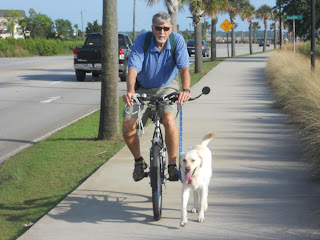The scenery continued to be marshy and water flat. Made for a nice trip. So odd to see boats "across" the marsh as we wind our way through the marshes.
 |
| Marsh, marsh and more marsh. |
 |
| These boats are winding and twisting through the marsh. |
 |
| Northern Spy is a 1954 Huckins. The yacht was restored and repowered with Volvo IPS drives in Rockport, Maine. Jim and I visited the Huckins Plant where Northern Spy was built in 1954. Huckins continues to build boats in the same style today in Jacksonville, along the Ortega River. |
 |
| Mathis Trumphy, 1919. Innisfail available for charter. |
 |
| Mega Dock means a long walk to doggy territory. |
 |
| Sailing ships and power boats line the Mega Dock at the Charleston City Marina. |
 |
| South Carolina State Flag |
We arrived in Charleston with High Spirits and located the Mega Dock, City Marina. It is a huge marina, though our preference would have been the Charleston Maritime Marina. Because of the Easter Holiday, the marina was full. They only have 25 slips and 1/2 are in water...that isn't deep enough.
 |
| We see these small cruise ships is many harbors, including those along the St. Johns River in Northern Florida. |
These few days have been packed full of good fun. We visited by tourist boat, Fort Sumter on an island in the middle of the Harbor. The Fort was built following the War of 1812. Granite was imported from England to build up a sandbar, located in the harbor. Fort Sumter is best known as the place where the first shots were initiated that started the Civil War.
 |
| The canons were found in the harbor and archaeologists took years to remove the salt from the cannons before they could be displayed. |
 |
| The Hunley is in a fresh water tank in North Charleston. |
 |
| This is the replica. The submarine remains in a fresh water tank and should be ready for display in two more years. |
My favorite was the H. L. Hunley Research Center. The Hunley is one of history's great maritime mysteries. On February 17, 1864, eight men entered an experimental vessel with a mission to sink the USS Housatonic. On that day, the H.L. Hunley became the first successful combat submarine in world history.
The Hunley rammed her spar torpedo into the hull of the Housatonic, causing the hugh warship to sink in 3 minutes. After completing the momentous feat, the Hunley crew signaled their success to shore, but were never seen again. To this day we do not know why they disappeared.
After being lost at sea for more than 130 years, the Huntley was located in 1995 and raised in 2000 by a crew organized by Clive Cussler. The sub was brought to the Charleston naval base and scientists continue to work to unlock the mysteries of the Hunley.The crew members were buried following a 4.5 mile horse-drawn caisson procession through downtown Charleston. Hundreds of journalists came to Charleston to cover what was called the last Confederate burial. As you can see, we thoroughly enjoyed the visit, though it took a long cab ride to the Research Center. Visits are only scheduled on weekends as the scientists continue to investigate the Hunley during the week.
 |
| Jim and Wayne in the replica which is 10% bigger than the actual submarine. The replica was built for a movie starring Donald Sutherland. |
 |
| Ruth and I had to give it a try. It was REALLY difficult. How did they get 4 miles out when it is so incredibly difficult? Being in the right place for an outgoing tide would help, but there was only so much oxygen.... |
Next we "cabbed" to Patriots Point and inspected the submarine USS Clamagore. The 322 foot diesel powered submarine was commissioned in June, 1945 and spent her 30 year career operating out of Key West, Charleston and New London, CT. She was decommissioned in 1975. The torpedo room was most interesting. Crew bunks surrounded the torpedoes and were located almost on top of each other.
 |
| Uss Clamagore |
The other ship we toured was the USS Yorktown, "the Fighting Lady". She is the 10th aircraft carrier to serve in the US Navy. She was commissioned in 1943 and played a significant role in the Pacific offensive in late 1943 that ended with the defeat of Japan in 1945.The ship is huge, but one can still not imagine carrying a crew of 3500 and 90 planes. She served in the Vietnam War and recovered Apollo 8, the first men to reach the moon. Decommissioned in 1970, she was towed to Yorktown and dedicated as a museum.
 |
| USS Yorktown. |
 |
| Boo, on the other hand, rides in his baby carrier. Since Mom is the photographer, this is the best picture we have of BooBoo. |
 |
| Before and after zinc. Jim replaced the zincs before we left Michigan and needed to be replaced again, obviously! |
 |
| Buddy and his Dad are getting a good workout. Will Marley, I mean Buddy ever settle down and be of those perfect yellow labs? |
Jim was again in the engine room checking things out. The impellers do not need to be replaced, but the zincs in the heat exchanger on the diesel engine, for example, need replacement. Zinc anodes are used as underwater protection against corrosion. When a boat has anodes, typically of zinc, they will corrode before other metals because zinc has more active voltage. There are zinc anodes attached to the hull, on the propeller shafts and other places, besides the engines.



















No comments:
Post a Comment